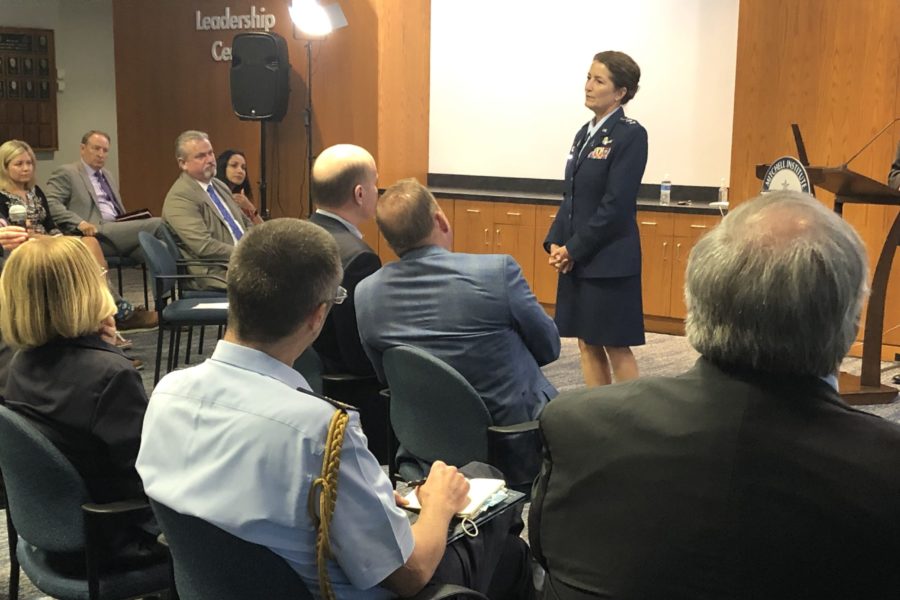The Space Force will begin to convert Sailors and Soldiers into Guardians this month and unit transfers from the Army and Navy will play out over the next couple of years. But just as the Air Force is not the only service with aircraft, the Space Force will not be the only service in space.
Lt. Gen. Nina M. Armagno, the Space Force’s director of staff, told Air Force Magazine the services are agreed on which organizations will transfer. “Some services may retain their own space capabilities.” She did not provide details, but said announcements will come on transfers later this year.
Speaking at a Mitchell Institute Space Power Advantage Research Center (MI-SPARC) Space Power Forum at AFA’s Doolittle Leadership Center, Armagno said transfers must play out slowly, in the next “year or two,” because shifting control is not like flipping a switch.
“When we transfer units and missions, we have to make sure that the mission does not fail,” Armagno said. “And so that requires deep evaluation, which we’re doing today.”
In a wide-ranging discussion that covered the progress made in the service’s first 18 months, Armagno zeroed in on the current threats posed by China and Russia, describing adversary anti-satellite capabilities and the largely vulnerable U.S. space architecture.
China’s Shijian-17 satellite has a robotic arm that can be used to grab and destroy an American satellite, she said. China has said the robotic arm in its technology is for repairing satellites or conducting maintenance in space, but she called that misleading.
“If you’re going to repair something, it needs to be repairable,” Armagno said. “If it’s going to be refueled, it needs to have a fuel port. … This is not the case with their satellites.”
U.S. satellites are likewise not designed to be refueled or repaired. “So, Shijian-17, we see it as a weapon,” she said.
Armagno also cited Russia’s recent testing of a ground-based anti-satellite weapon designed to destroy small satellites in low Earth orbit. Such threats gets at the heart of the creation of the new service, Armagno said, deterring aggression and assuring space operations, which are vital to the ground forces.
Armagno listed the commands that have already stood up, including Space Operations Command (SpOC) in Colorado Springs in 2020 and this summer’s upcoming Space Systems Command (SSC) in Los Angeles, and she previewed the upcoming Space Training and Readiness Command (STARCOM).
She also spoke of a flattened management structure in the Pentagon headquarters to encourage efficiency and creativity. The “C suite” leadership design was assisted by private consultants and modeled after the structure of the National Reconnaissance Office. Still, only some 250 staff members have onboarded at the headquarters, about one third of the total envisioned.
Space Force now has 5,600 Guardians and about 12,000 personnel at present. Armagno said the vision is for a “lean, agile, and mission focused” service that totals about 16,000, a goal that may be some years off, she indicated.
In part, budget restrictions have limited the number of transfers from other services to just 50 this fiscal year, with another 350 planned for the next fiscal year, the Space Force indicated June 30. The Space Force in 2020 advertised 41 civilian jobs and received 5,722 applicants, demonstrating a much higher demand than growth rate.
Armagno admitted that new strategies will have to be employed to recruit and retain talent and compete with the high-paying private space industry.
“We just don’t think the traditional Air Force, if you will, or even Army, Navy recruiting methods are necessarily going to work for the Space Force,” she said. “We’re looking for a certain level of innovation and creativity.”
Congress, too, has limited how quickly Space Force can staff up.
Thousands of Air Force personnel remain administratively assigned to Space Force and have not yet been transferred. Likewise, the Army and Navy are not required to transfer their space assets, so Chief of Space Operations Gen. John W. “Jay” Raymond must negotiate with the services to voluntarily give up their assets, and potentially, their personnel.
Armagno said Space Force does not need new congressional authority.
“No, we don’t lack congressional authority. The services are working together,” she told Air Force Magazine.
The transfer process for personnel is stipulated by Congress to be voluntary, which means the service members in those positions may choose to stay with their service or must be counted and undergo training as Guardians. A training pipeline has to be set up to support the mission.
“I think you’ll see—this calendar year and into next—you’ll see the majority of our transfers,” she added.
Editor’s Note: This story was corrected on July 2 and updated with additional information from the Space Force. The original incorrectly stated the number of units moving that will transfer and the stage of interservice negotiations about what units will move. Those decisions are complete, but not yet announced, the Space Force said.
